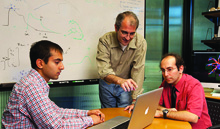A team of Stanford University, California, researchers have designed what they say is the fastest, most accurate mathematical algorithm yet that could allow implantable brain-computer interfaces (BCIs) to control a prosthetic arm with the speed, accuracy, and natural movement that approach those of a real arm, or control a cursor on a computer screen by thought alone. The results of their work were published November 18 in the journal Nature Neuroscience.
The Recalibrated Feedback Intention-Trained Kalman filter (ReFIT) algorithm relies on a sensor implanted into the brain-the BrainGate-that records “action potentials” in neural activity from an array of electrode sensors and sends data to a computer. The frequency with which action potentials are generated provides the computer information about the direction and speed of the user’s intended movement.

From left, Stanford researchers Gilja; Krishna Shenoy, PhD, associate professor in the Departments of Electrical Engineering, Bioengineering (affiliate), and Neurobiology (courtesy), Stanford, School of Engineering; and graduate student researcher Paul Nuyujukian.
The ReFIT algorithm allows the Stanford team to understand how the system works “online,” under closed-loop control conditions in which the computer analyzes and implements visual feedback gathered in real time as the subject neurally controls the cursor toward an onscreen target. This is a departure from earlier models in which data from recorded brain activity of a subject moving or imagining moving an arm is analyzed after the fact.
The system was tested in side-by-side demonstrations with rhesus monkeys who had previously received the BrainGate implant. Cursors controlled by the new algorithm followed a path from the starting point to the target that was straighter and reached the target twice as quickly as earlier systems, achieving 75 to 85 percent of the speed of the monkey’s arm. The system is also able to make adjustments on the fly when guiding the cursor to a target, just as a hand and eye would work in tandem to move a mouse-cursor onto an icon on a computer desktop. The team designed the system to learn from the user’s corrective movements, allowing the cursor to move more precisely than it could in earlier prostheses. Critical to ReFIT’s time-to-target improvement was its ability to stop the cursor quicker than in prior models so that the target was not overshot. This was accomplished by using a step-by-step calculation that transforms electrical signals from the brain into movements of the cursor onscreen.
To “train” the algorithm about movement, the computer used signals from the implant to match the actual arm movements of the monkey moving the cursor with neural activity. Next, the monkey thought about moving the cursor, and the computer translated that neural activity into onscreen movement of the cursor. The team then used the monkey’s brain activity to refine their algorithm, increasing its accuracy.
The team introduced a second innovation in the way ReFIT encodes information about the position and velocity of the cursor. Engineering research associate at the Stanford Institute for Neuro-Innovation & Translational Neuroscience, Vikash Gilja, PhD, said that previous algorithms could interpret neural signals about either the cursor’s position or its velocity, but not both at once. ReFIT can do both, resulting in faster, cleaner movements of the cursor.
In another departure, the researchers abandoned the approach of early neural prosthetics research to differentiate among individual neurons in the brain and instead the ReFIT focuses on small groups of neurons. While the individual neuron approach has allowed neuroscientists to create a detailed understanding of the individual neurons that control arm movement, it is more difficult and potentially error prone, Gilja said. In addition, neural implant systems that are fine-tuned to specific neurons degrade over time. By taking the group neuron approach the researchers achieved performance longevity with the BrainGate device; they said that more than four years after implantation, the system is still going strong, while previous systems have seen a steady decline in performance over time.
For the time being, the team has been focused on improving cursor movement, rather than the creation of robotic limbs, but that is not out of the question, Gilja said. The team is now translating these innovations to people with paralysis as part of a clinical trial.




